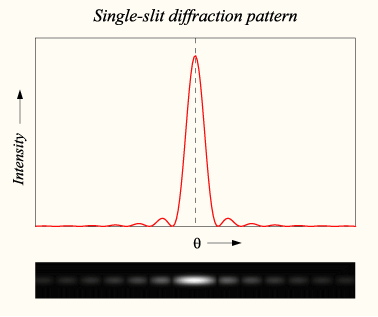 |
|
| Browse | Ask | Answer | Search | Join/Login |
|
|
||||
|
Light spread -
Like in a slit experiment, is there a way to determine the angle of refration after the light exits the slit? If a point source of light is next to, and at the bottom of the straight edge, what will be the angle if refraction when the light gets to the end of the straight edge?
|
||||
|
||||
|
I believe you mean the angle of diffraction, not refraction. Anyway, no there's no way to determine the angle of diffraction. You can only determine the relative probability that a photon will diffract at a particular angle.
You probably already know this, but when light passes through a slit or along the edge of a straight-edge, it diffracts on the other side. In the case of a constant monochromatic point light source, a diffraction pattern is formed which demonstrates the wave-like nature of light. The brightness of the resulting pattern as a function of the angle varies. If you then turn off the constant light source and send a single photon through the slit or along the straight-edge, it could "bend" (a.k.a. diffract) to pretty much any angle. However, the likelihood of it bending to any particular angle is proportional to the brightness of the diffraction pattern from when the constant light source was on. If you look at this picture from this Wikipedia article, you can see that the diffraction pattern through a single slit is a sinc^2 function. This tells you that there's a strong likelihood that the photon's path won't be bent much at all, but there's still a non-too-unlikely chance that it'll be bent to one of the adjacent diffraction nodes.  In other words, if you send 100 photons through the slit, they will be bent at 100 different angles. Most will be within a few degrees of the original direction of propagation (hence the bright area in the middle of the diffraction pattern), but a few may be bent significantly. |
||||
Not your question?
Ask your question
View similar questions
| Question Tools | Search this Question |
Add your answer here.
Check out some similar questions!
If light is radiated from a point source, how is it spread?
[ 2 Answers ]
What isn't the distance between rays.
My Documents appear too spread out
[ 1 Answers ]
In switching to Vista I fined My documents appear on the screen far too wide to read comfortably, and spread out horizontally so that I have to progress the mouse along the screen left to right for each sentence to read, then go back and repeat for next line. Former XP has documents in form that's...
How is it spread?
[ 4 Answers ]
Can you get herpes others ways than sexual intercourse/ anything sexual??
Spread some reputation
[ 3 Answers ]
Ok' I'm new to this site. Will some one explain the phrase "spread some reputation around"? Thanks, Prairie Son:confused:
View more questions Search
|




